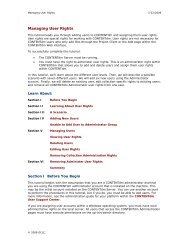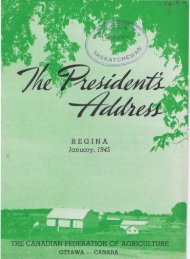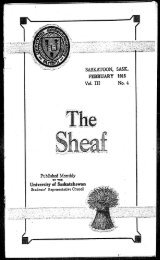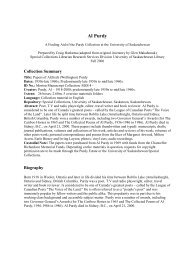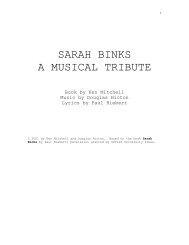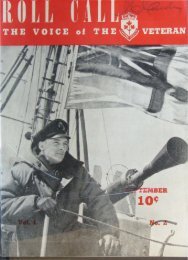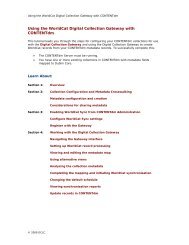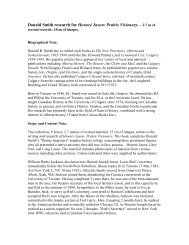download pdf here - Library2 - University of Saskatchewan
download pdf here - Library2 - University of Saskatchewan
download pdf here - Library2 - University of Saskatchewan
You also want an ePaper? Increase the reach of your titles
YUMPU automatically turns print PDFs into web optimized ePapers that Google loves.
THE A.W. PURDY COLLECTIONThe <strong>University</strong> <strong>of</strong> <strong>Saskatchewan</strong> collection <strong>of</strong> the booksand papers <strong>of</strong> the Canadian writer Al Purdy is one <strong>of</strong>two major holdings <strong>of</strong> his work to 1967, the otherbeing at Queen's <strong>University</strong> in Kingston, Ontario. The<strong>University</strong> <strong>of</strong> Toronto also has a small but noteworthycollection.The <strong>Saskatchewan</strong> holdings, acquired in· 1966 throughMontreal literary agent Laurie Hill, include the earliestpreserved Purdy materials. The most interesting <strong>of</strong>these are a little book <strong>of</strong> birchbark pages onto whicha poem entitled "Reilly" has been typed and sevensmall typescript books <strong>of</strong> largely unpublished or uncollectedpoetry dated as far back as March, 1939. Thevolumes, which are titled "The Road to Barbary", "APrairie Odyssey", "Robin Hood", "The Land Over Yonder"(which incorporates the Robin Hood sequence), and"Songs <strong>of</strong> the Restless Ones", are filled with predominantlyundistinguished poems that show little <strong>of</strong> theoriginality <strong>of</strong> vision which was to characterizePurdy's mature work.T<strong>here</strong> are a large number <strong>of</strong> manuscripts that wouldallow the interested person to trace Purdy poems fromthe earliest holograph stage through to revised typescriptforms. The drafts are written on an astoundingnumber <strong>of</strong> scrap paper forms, ranging from the back <strong>of</strong>Vancouver General Hospital X-ray forms, through financeand drug company letterhead, and an opened-outbox <strong>of</strong> Trump cigars to a tissue. Occasionally draftsare accompanied by a note or brief letter indicating
- 2 -the originals behind portraits, sources <strong>of</strong> the poem orpoetic influences. So, writing <strong>of</strong> three poems publishedin The Cariboo Horses (Toronto: McClelland andStewart, 1965), Purdy identifies the factory <strong>of</strong> "TheMachines" as Vancouver Bedding on Clark Drive, thetitle character <strong>of</strong> "Old Alex" as Alex Carmichael, andthe source <strong>of</strong> the title quotation "'Malachi Stilt-JackAm I'" as a Yeats poem. The young poet being elegizedin "The Death <strong>of</strong> a Young Poet" from Wild Grape Wine(Toronto: McClelland and Stewart, 1968), is, accordingto Purdy, Red Lane, who died suddenly on December 1,1964, and the influences on Purdy's poem "Ballad <strong>of</strong>the Despairing Wife", published in The Cariboo Horses,are identified as Robert Creeley's "Ballad <strong>of</strong> theDespairing Husband" and "The Door", which both appearedin Donald Allen's The New American Poetry (NewYork: Grove Press, 1960).Among the more interesting <strong>of</strong> the miscellaneous papersin the collection is a receipt dated October 2, 1963for thirteen dollars from the Magistrate's Court inTrenton which, Purdy reveals on the reverse side,relates to the incident about which "Complaint Lodgedwith L.C.B.O. By a Citizen in Upper Rumbelow" waswritten. T<strong>here</strong> is also the only extant copy <strong>of</strong> thedirge for E.J. Pratt that Purdy mentions in No OtherCountry (Toronto: McClelland and Stewart, 1977),p.125. It was composed by Louis Dudek, Michael Gnarowskiand Purdy on their way to a poetry conference andit is meant to be sung to the tune <strong>of</strong> "The Bonnie Earl<strong>of</strong> Moray":
-~DI..N"'" b "''''.....""'" ........, ""POl..8.11t l.1Jl& tllru PUb. Brll'teYerd. "Our l'Ul.r JIlU.. 1a Ade." •... "U.,., , " l IlIl..Tal'd••"" "·H "OU' ,.,..reI t at .lle4 1r1 tJa h.1Al>..../1 -1taOllt • Pee.t1JlC111ncto.,. 4aJ'OO~.IU.I ~ , .. ' " " r" .l .• Q , l )'X·.pJ11'te••··"1'8t10•• or 11ae;y d.adg U".1r We1gbt Q.Il .. betq U'b~e.l'_bl)··&tle.l1 ~tJae. aOCll81Jl& .. 01" b4YtJl& .0 Pe.o"!t~ " '-"",.tol, .....,...~~. ~1 VdUl~ ••'......... quacked -.lidb_. .ll1." 'oo,It ... d""lOll fo.rel,..l'"at'. alrIght." I IlUtt."'dP l eY1a. 1'01' t1' r ~La...hl'.~....'r "" ... • "'; 'orl••ft. 81t.-.,"4:f""lSI(fd d"~r.t.l"te~ tl11. -ea 11 8
- 3 -Cold stands the harbor and chill lies the sandW<strong>here</strong> the bull winds <strong>of</strong> Labrador go down to Newfoundland;Grey be the fishing boats with nets along their sideAnd the ragged gulls go mournfully a-searching on the tide.Long will the fisherfolk wait upon the strandEre the man who hymned the whalers comes back to Newfoundland.Down from the shanties he came to the shoreAnd he left the foggy islands to see them no more;He went to make his fortune w<strong>here</strong> the big cities areBut he sang <strong>of</strong> the kraken and the Cachalot afar.Long will the fisherfolk wait upon the strandEre the man who hymned the whalers comes back to Newfoundland.In addition to the holograph and typescript versions<strong>of</strong> the majority <strong>of</strong> Purdy's poems written by 1967,t<strong>here</strong> are also in the collection a large number <strong>of</strong>journals in which Purdy published, so that scholarscan see the poems at virtually every stage <strong>of</strong> theirdevelopment. The one notable exception is the pagepro<strong>of</strong> stage <strong>of</strong> the books, for only the pro<strong>of</strong>s forNorth <strong>of</strong> Summer (Toronto: McClelland and Stewart,1967), found their way into the <strong>University</strong> <strong>of</strong> <strong>Saskatchewan</strong>collection. All <strong>of</strong> the books that Purdy published,up to and including North <strong>of</strong> Summer are in thecollection, though the rare limited edition, The Questfor Ouzo (privately printed, 1970), is not a boundcopy and some pages are present in multiple copies.The unpublished "Yehl the Raven and Other Myths <strong>of</strong> theHaida", which is based on the folktale collections <strong>of</strong>Marius Barbeau, is also in the collection, as are thepro<strong>of</strong>s <strong>of</strong> Purdy's article on Barbeau published inCanada Month, 3 (Sept. 1963), 11, under the title "AnOld Man's Memories <strong>of</strong> Indian Days".
- 4 -Careful scrutiny <strong>of</strong> the <strong>University</strong> <strong>of</strong> <strong>Saskatchewan</strong>Purdy collection shows that Purdy <strong>of</strong>ten exploits thesame mate.rials in a variety <strong>of</strong> forms and genres. Thebeginnings <strong>of</strong> what was to be an autobiographical novelcalled "The Iron Road" is present in holograph form,but this work was later twice revised, appearing firstin Canada Month, 3 (July 1963), 23-24, and then in theonly collection <strong>of</strong> prose Purdy has published to date,No Other Country. Part <strong>of</strong> these materials was alsogiven poetic form and appeared under the title "Transient"in Tamarack Review, No.27 (Spring 1963), 67-68.In a similar way, Purdy was unable to complete a playhe began to write about Leo Szilard~ one <strong>of</strong> the.physicists who helped to create the H-bomb, but thematerials were worked into a successful poem, "Biography",which appeared in Poems for All the Annettes(Toronto: Contact Press, 1962).Another story that has undergone considerable transformation,appearing as both prose and poetry, is that <strong>of</strong>Purdy's relationship with and knowledge <strong>of</strong> MalcolmLowry. As early as The Crafte So Long to Lerne (Toronto:Ryerson Press, 1959), Purdy was writing aboutLowry in "About Pablum, Teachers, and Malcolm Lowry",and a prose elegy for Lowry by Purdy appeared involume 1 <strong>of</strong> the little magazine, Moment:" in hisnightmare he screamed, and the screams were his poems.Few <strong>of</strong> us make such sounds, or make them co<strong>here</strong>ntly.He's dead, but his poems know what it is like to bealive." (p. 9) . The second number <strong>of</strong> Moment publishedLowry's "Sestina in a Cantina", a poem which Lowry hadrecited for Purdy when the Ontario poet had visitedhim in' his ocean-side shack in Dollarton. Purdy wrote
- 6 -title character, Gwyn Thompson, is a thinly veiledWill Roblin, grandson <strong>of</strong> the original mill owner, OwenRoblin. In the story Owen bears a different last name(Thompson) and was born three years earlier and diedone year before his historical counterpart, but thetwo are otherwise identical. "The Life and Death <strong>of</strong> aVillage" is a journalistic piece about Ameliasburg andOwen Roblin that documents Purdy's thoughts as he wascaught by and explored the history <strong>of</strong> his adopted home.The beginnings <strong>of</strong> an autobiographical novel, "15,000Horses", also in the Purdy collection, tells the story<strong>of</strong> Purdy's life in the taxi business, but the novelwas abandoned.The many rejected play-scripts that Purdy mentioned in"No Other Country" range in subject matter from thelife <strong>of</strong> Vancouver skid-row bums, through family lifein various degrees <strong>of</strong> awfulness, aging, retirement anddeath, an Indian who gets involved· in politics, ablack man who goes to live with the Indians, and theadvent <strong>of</strong> the white man to the Arctic, to historicalevents and personages such as the World Wars, Hannibal'sassassination and the story <strong>of</strong> Helen <strong>of</strong> Troy. Aplay called "The Streets <strong>of</strong> the City" did for Montrealwith A.M. Klein's poems what Purdy had done with hisown verse in the Vancouver script, but copyright problemsprevented the Klein programme from ever reachingthe air. Purdy's dramatization <strong>of</strong> Earle Birney's"David", while fairly predictable in its interpretationand fleshing out <strong>of</strong> the story <strong>of</strong> David and Bobbie(David is pictured as a practical joker in the surveycamp and Bobbie's attachment to David is motivated by
- 7 -Bobbie's having lost his father), was at least broadcast.In "The Soundless Storm" Purdy took a satiric look atthe in-fighting among poets, in particular the Montrealgroup. Poets like Clarence Brubeck (Louis Dudek),Herman Blatant (Irving Layton), Beryl Kine (DarylHine) , Poetess Miriam (Miriam Waddington) and PhyllisFillet (Phyllis Webb) exchange cutting remarks, largelydirected at the sell-out Brubeck. Critics <strong>of</strong> courseget in on the sport too, and Northrop Frye is deftlyreduced by Purdy to the mundane, Poach.A projected television drama, "Mice in the Woodwork",set in a Montreal, St. Lawrence and Main area nightclub,uses poems- <strong>of</strong> both Al Purdy and Milton Acorn,and the tension between the two friends' opposingpolitical and artistic views provides the reason forreading, defending and explaining (<strong>of</strong>ten in considerabledetail) a series <strong>of</strong> the two men's poems. Theprincipal interest <strong>of</strong> the play for readers <strong>of</strong> Canadianpoetry, besides the explication <strong>of</strong> the poems, is theinsight it gives into the Purdy-Acorn relationship.After some argument between the pair Purdy explains tothe audience:We've been friends for ten years, but he's apolitical idealist and I'm a social realist.It rather strains the bonds <strong>of</strong> friendship between us ••••[to Acorn] But you'll keep your faith in a corruptpolitical system, and I'll continue to believein individual goodness •••• No, the only thing Ibelieve in is life itself.Further information about Purdy and Acorn can begleaned from other parts <strong>of</strong> the collection. The three
- 8 -numbers <strong>of</strong> the short-lived mimeo-magazine, Moment,that the two edited together in 1959 is "one suchsource. In "Poets in Montreal" from No Other CountryPurdy writes about the history <strong>of</strong> his relationshipwith Acorn and explains the movitation behind Moment,revealing that it was begun for reasons "egotistic (wewanted to publish our own poems ... ) and altruistic(we wanted to publish good poems by other people)"(p.127). In the first number a conversation on RaySouster's poetry among Acorn, Dudek and Purdy concludeswith the latter having the last word: "I likeSouster, Birney, Layton, Finch, Pratt. and I thinkcatholicism is best." The general tone <strong>of</strong> this littlemag. might best be deduced from F.R. Scott's contribution,"The Bartail Cock", which was signed "(S.R.F.)".The closeness <strong>of</strong> Purdy and Acorn is suggested by theformer's copy <strong>of</strong> Acorn's The Brain's the Target whichis inscribed to Al Purdy "Who taught me more aboutimagery than I'll ever know", but it is the correspondencebetween them that fills in the details. Theseletters are invaluable to students <strong>of</strong> both Purdy andAcorn, as political and poetic theories, publishingand personal details, including the smooth and rockyparts <strong>of</strong> the two men's relationship, are all documented<strong>here</strong>. In a letter dated 15/9/60 to Bob McCormack,Programme Organizer <strong>of</strong> the C.B.C., Acorn asks ifPurdy could read a selection <strong>of</strong> Acorn's poems to bebroadcast on the network since Purdy had kept a sympatheticeditor's eye on the other's poems, had been akind <strong>of</strong> godfather to Acorn's writing and was a constantenthusiast and prodder to get Acorn to publish.
- 9 -T<strong>here</strong> is much <strong>of</strong> interest and value in the Purdycollection correspondence, and t<strong>here</strong> are few if anyCanadian poets and editors working in the fifties andsixties who are not represented <strong>here</strong>. The letters fromLorne Pierce are fascinating, especially one datedJuly 30, 1958 which discusses the circumstances surroundingRaymond Knister's death,circumstances Pierceclearly found as strange as those surrounding TomThomson's death. Letters from Earle Birney discuss,among other things, the source and diction <strong>of</strong> "Mappemounde"and what Birney calls the "scattered and unconcentratedinfluences" on his work. American poetCharles Bukowski was certainly the most graphic andcolourful <strong>of</strong> Purdy's correspondents for Bukowski's lettersare frequently illustrated with paintings or drawings,but the written contents, when not reflectingmutual admiration, are largely despairing and <strong>of</strong>tenshow the effects <strong>of</strong> too much alcohol.In this way they resemble many <strong>of</strong> John Newlove'sletters. But Purdy had been instrumental in findingNewlove a publisher, and the latter clearly consideredPurdy a close and genuine friend. Correspondence withMargaret Atwood and William Toye <strong>of</strong> Oxford <strong>University</strong>Press shows that Purdy introduced Atwood to her presentpublisher, and the wry affection she felt forPurdy is indicated by her inscription <strong>of</strong> The CircleGame (Toronto: House <strong>of</strong> Anansi Press, 1966), "To AwfulAl from Perfect Peggy".T<strong>here</strong> is also some revealing correspondence with IrvingLayton, Dorothy Livesay and George Bowering, aswell as some curious letters from John Glassco which
- 10 -indicate a paradoxically lively exchange on car cemeteries.Glassco's characteristic closing, "Automorphicallyyours", gives some idea <strong>of</strong> the tone <strong>of</strong> thoseletters, but Purdy's poem lIMy '48 Pontiac" may wellhave been stimulated by this exchange <strong>of</strong> letters.Purdy does not seem to have been particularly successfulin getting his prose published, though <strong>of</strong> thetwelve short stories in the collection (some articleshave been catalogued as short stories) t<strong>here</strong> are atleast three that have been printed in periodicals andat least two more that seem worthy <strong>of</strong> publication. Hewas more successful in placing articles and reviews,many <strong>of</strong> which have been preserved in the collection."A Kind <strong>of</strong> Witness", an article and poems aboutPurdy's arctic e~periences, forms an interesting glossto the volume <strong>of</strong> poetry North <strong>of</strong> Summer. Purdy hasreviewed not only a good number <strong>of</strong> books <strong>of</strong> poetry,but also novels, biographies and books relating toplaces he has visited such as the arctic or Newfoundland.The only axe Purdy seems to have to grind in hisreviews is with the Tish or Black Mountain group, andthis is not because <strong>of</strong> their poetic practice, butrather what he sees as their intolerance <strong>of</strong> any otherway <strong>of</strong> writing poetry but their own.Purdy's scrapbooks <strong>of</strong> his earliest periodical publicationsand the reviews <strong>of</strong> his work up to 1965 help t<strong>of</strong>ill in the history <strong>of</strong> the early years <strong>of</strong> A.W. Purdy,poet, and make it possible to map critical reaction tohis work, which on the whole, has been strikinglyfavourable.
- 11 -Other noteworthy parts <strong>of</strong> the Purdy collection arefour illustrated broadsheets put out by Tako Tanabewhich reproduce the Purdy poems, "Lament for RobertKennedy", "The Horsemen <strong>of</strong> Agawa", "The Peaceable Kingdom"and "Nine Bean Rows on the Moon", and a completeset <strong>of</strong> tapes <strong>of</strong> Purdy reading his own poetry, beginningwith The Enchanted Echo and working up to North<strong>of</strong> Summer, adding for good measure a few prose piecesthat had been previously published.Susan BeckmannDepartment <strong>of</strong> English.



